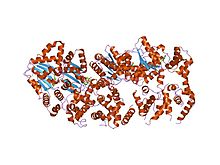DnaA
| Chromosomal replication initiator protein dnaA | |||||||
|---|---|---|---|---|---|---|---|
| Identifiers | |||||||
| Organism | |||||||
| Symbol | DnaA | ||||||
| Entrez | 948217 | ||||||
| RefSeq (Prot) | NP_418157.1 | ||||||
| UniProt | P03004 | ||||||
| Other data | |||||||
| Chromosome | genome: 3.88 - 3.88 Mb | ||||||
| |||||||
| Bac_DnaA_C | |||||||||
|---|---|---|---|---|---|---|---|---|---|
 crystal structure of dnaa domainiv complexed with dnaabox dna | |||||||||
| Identifiers | |||||||||
| Symbol | Bac_DnaA_C | ||||||||
| Pfam | PF08299 | ||||||||
| Pfam clan | CL0123 | ||||||||
| InterPro | IPR013159 | ||||||||
| SCOP2 | 1j1v / SCOPe / SUPFAM | ||||||||
| |||||||||
| Bac_DnaA | |||||||||
|---|---|---|---|---|---|---|---|---|---|
 structure of amppcp-bound dnaa from aquifex aeolicus | |||||||||
| Identifiers | |||||||||
| Symbol | Bac_DnaA | ||||||||
| Pfam | PF00308 | ||||||||
| Pfam clan | CL0023 | ||||||||
| InterPro | IPR013317 | ||||||||
| PROSITE | PDOC00771 | ||||||||
| SCOP2 | 1j1v / SCOPe / SUPFAM | ||||||||
| |||||||||
DnaA is a protein that activates initiation of DNA replication in bacteria.[1] It is a replication initiation factor which promotes the unwinding of DNA at oriC.[1] The onset of the initiation phase of DNA replication is determined by the concentration of DnaA.[1] DnaA accumulates during growth and then triggers the initiation of replication.[1] Replication begins with active DnaA binding to 9-mer (9-bp) repeats upstream of oriC.[1] Binding of DnaA leads to strand separation at the 13-mer repeats.[1] This binding causes the DNA to loop in preparation for melting open by the helicase DnaB.[1]
Function[]
The active form DnaA is bound to ATP.[1] Immediately after a cell has divided, the level of active DnaA within the cell is low.[1] Although the active form of DnaA requires ATP, the formation of the oriC/DnaA complex and subsequent DNA unwinding does not require ATP hydrolysis.[2]
The oriC site in E. coli has three AT rich 13 base pair regions (DUEs) followed by four 9 bp regions with the sequence TTAT(C or A)CA(C or A)A.[3] Around 10 DnaA molecules bind to the 9 bp regions, which wrap around the proteins causing the DNA at the AT-rich region to unwind. There are 8 DnaA binding sites within oriC, to which DnaA binds with differential affinity. When DNA replication is about to commence, DnaA occupies all of the high and low affinity binding sites. The denatured AT-rich region allows for the recruitment of DnaB (helicase), which complexes with DnaC (helicase loader). DnaC helps the helicase to bind to and to properly accommodate the ssDNA at the 13 bp region; this is accomplished by ATP hydrolysis, after which DnaC is released. Single-strand binding proteins (SSBs) stabilize the single DNA strands in order to maintain the replication bubble. DnaB is a 5'→3' helicase, so it travels on the lagging strand. It associates with DnaG (a primase) to form the only primer for the leading strand and to add RNA primers on the lagging strand. The interaction between DnaG and DnaB is necessary to control the longitude of Okazaki fragments on the lagging strand. DNA polymerase III is then able to start DNA replication.
DnaA is made up of four domains: the first is the N-terminal that associates with regulatory proteins, the second is a helical linker region, the third domain is a AAA+ region that binds to ATP, and the fourth domain is the C-terminal DNA binding region.[4] DnaA contains two conserved regions: the first is located in the central part of the protein and corresponds to the ATP-binding domain, the second is located in the C-terminal half and is involved in DNA-binding.[5]
Synthesis[]
DnaA has the ability to bind its own promoter. When DnaA binds to its own promoter it blocks RNA polymerase from binding the promoter and inhibits initiation of transcription. In this way, DnaA is able to regulate its own expression.[6][7] This process is called autoregulation.
See also[]
References[]
- ^ a b c d e f g h i Foster JB, Slonczewski J (2009). Microbiology: an evolving science. New York: W.W. Norton & Co. ISBN 978-0-393-97857-5.
- ^ Leonard AC, Grimwade JE (December 2010). "Regulating DnaA complex assembly: it is time to fill the gaps". Curr. Opin. Microbiol. 13 (6): 766–72. doi:10.1016/j.mib.2010.10.001. PMC 3005629. PMID 21035377.
- ^ Fuller RS, Funnell BE, Kornberg A (October 1984). "The dnaA protein complex with the E. coli chromosomal replication origin (oriC) and other DNA sites". Cell. 38 (3): 889–900. doi:10.1016/0092-8674(84)90284-8. PMID 6091903. S2CID 23316215.
- ^ Costa A, Hood IV, Berger JM (2013-01-01). "Mechanisms for initiating cellular DNA replication". Annual Review of Biochemistry. 82: 25–54. doi:10.1146/annurev-biochem-052610-094414. PMC 4696014. PMID 23746253.
- ^ Roth A, Messer W (May 1995). "The DNA binding domain of the initiator protein DnaA". EMBO J. 14 (9): 2106–11. doi:10.1002/j.1460-2075.1995.tb07202.x. PMC 398312. PMID 7744016.
- ^ Hansen FG, Atlung T (2018-02-28). "The DnaA Tale". Frontiers in Microbiology. 9: 319. doi:10.3389/fmicb.2018.00319. PMC 5835720. PMID 29541066.
- ^ Speck C, Weigel C, Messer W (November 1999). "ATP- and ADP-dnaA protein, a molecular switch in gene regulation". The EMBO Journal. 18 (21): 6169–76. doi:10.1093/emboj/18.21.6169. PMC 1171680. PMID 10545126.
Further reading[]
- Pratt CA, Voet D, Voet JG (2012). Fundamentals of Biochemistry: Life at the Molecular Level. New York: Wiley. ISBN 978-0-470-54784-7.
- Cox M, Nelson DR (2008). Lehninger Principles of Biochemistry. W H Freeman & Co. (Sd). ISBN 978-1-4292-2416-1.
- Scholefield G, Errington J, Murray H (2012). "Soj/ParA stalls DNA replication by inhibiting helix formation of the initiator protein DnaA". The EMBO Journal. 31 (6): 1542–1555. doi:10.1038/emboj.2012.6. PMC 3321191. PMID 22286949.
External links[]
- DnaA+protein,+Bacteria at the US National Library of Medicine Medical Subject Headings (MeSH)
- Biomolecules
- DNA replication